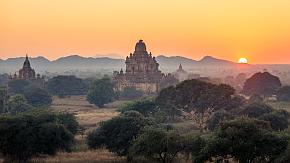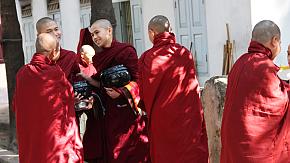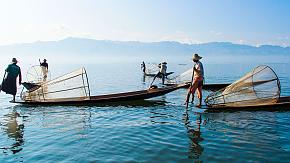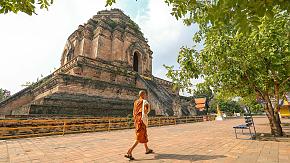Travelling Myanmar: The Road to Mandalay
It was the names that fascinated me. As I child, I'd read what I now know to be books celebrating and glorifying colonialism in Southeast Asia. But, in my innocence, they were a source of endless wonder; a Disneyland in words. These books described magical, impossible places full of the marvelous. Happy tree-carrying elephants strolled past shiny golden buildings in places with exotic names like Rangoon and Mandalay. Giant, man-eating crocodiles lay in wait in the Irrawaddy River while even hungrier tigers lurked in the forests on the bank.
Then sadly, I grew up and learned that life isn't really quite a fairy tale. Kipling's poem The Road to Mandalay which I happily recited wasn't about what I thought it was, at all. Burma, as it was still then known, was in fact a deeply troubled country with a long history of political strife, civil war, and occupation. Only in 2010, did the military partly give up its total control of the country, allowing its dormant tourist industry to begin to make a comeback. As a result, the tourist infrastructure and facilities in what is now known as Myanmar are less developed than those in other parts of Southeast Asia.
There is however a plus side to this. Visitor numbers are still relatively low, meaning that the main sites are seldom crowded. As tourism increases and revenues come in, the infrastructure should improve but the improvements bring more and more tourists. The Catch-22 of travel. This means that now is perhaps the best time to visit this fascinating, beautiful country, while it remains largely unspoiled.
So, let me revisit the sites of my childhood daydreams and see what they have to offer in real life!
1. Yangon
In 1989, Burma officially changed its name to Myanmar and at the same time changed the name of its then capital, Rangoon to Yangon, along with many other place name changes. These changes were said to be, in part, to disassociate the country from its colonial past, although some of these changes remain controversial both in and outside the country.
Rangoon became the country's capital under British rule in 1852 and remained such even after renaming until 2006 when the military moved the capital to the new, purpose-built city of Nay Pyi Taw. However, Yangon remains Myanmar's most populous city and most important commercial center. It is also the location of some of the country's most iconic sights.
Shwedagon Pagoda, a 99 meter/326 feet tall, gold-covered stupa sitting on a hill overlooking Yangon, dominates the city and skyline like no other building does to a city. It is Myanmar's most sacred Buddhist site and is said to contain relics of four Buddhas, including Siddhārtha Gautama, the founder of Buddhism, the religion of 96% of Myanmar's people. The huge pagoda is believed by historians to have been built sometime between the 6th and 10th centuries AD, although tradition claims that it is around 2,600 years old. At various times over the centuries, it has fallen into disrepair and neglect, but always eventually been restored. Earthquakes have visibly distorted its original symmetry yet it remains truly majestic.''
 Shwedagon Pagoda in Yangon
Shwedagon Pagoda in Yangon
The gilding is made of real gold plates riveted to the underlying brick structure and it is considered a matter of great piety (and a source of good karma) to donate gold to Shwedagon for repairs and restoration. This centuries-old practice dates back to the 15th century when Queen Shin Sawbu donated her weight in gold.
NOTE: When visiting Buddhist sites in Myanmar, visitors are required to remove not only shoes, but also any socks before entering. Also hats are not allowed and shorts, short skirts and bare shoulders etc are considered very disrespectful. Taking photos of Buddha statues is considered to be sacrilegious, especially if you or a friend pose with the Buddha. Finally, you should never point your feet towards the Buddha (or any person), but sit with your feet tucked behind you, mermaid style.
Yangon has a number of Buddhist temples and other sites, all of which are worth visiting. Chaukhtatgyi Buddha Temple in Yangon's Bahan Township is home to a 66 meter/217 feet long reclining Buddha, whose specially made glass eyes are a full 1.77 metres/5 feet 10 in width. This is one unusual Buddhist site well worth making a side trip to.
If you want a break from temples and pagodas and sample some of Yangon's daily life Bogyoke Aung San Market (known as Scott's market in the colonial days) is the place to go. The market is in two parts. The older part, with its colonial architecture, has many small shops selling old coins and banknotes, stamps etc. There are also jewellers selling jade and precious stones. Here you can also find restaurants, art galleries, and clothing stores.
Across the main road is the new wing of the market which caters more to locals and their daily needs. This is where to find local foods, medicines, and a limited range of imported consumer goods. This will also allow you a glimpse of Yangon's daily life away from the tourist circuit.
2. Bago and Golden Rock
The city of Bago lies 91 km/57 miles north-east of Yangon (about an hour-and-a-half by car). Again, there are a number of Buddhist sites, including another reclining Buddha, the Shwethalyaung Buddha and the bell-shaped Shwemawdaw Pagoda, at 114 meters/374 feet, Myanmar's tallest. Originally built in the 10th century, but repeatedly destroyed by earthquakes, most recently in 1930, the current stupa is celebrated by a 10-day festival every year (around April-May).
About three-and-a-half hours away is Kyaiktiyo Pagoda, more commonly known as the Golden Rock. This is a 7.3 meter / 24 feet pagoda built on the top of an apparently precariously balanced granite boulder covered with gold leaf which is pasted on by male believers. The best time to take photographs of the Golden Rock is at dawn. Kyaiktiyo Pagoda (Golden Rock)
Kyaiktiyo Pagoda (Golden Rock)
There is a nearby village, Potemkin which has a number of restaurants, guest houses gift shops, etc.
NOTE: Women are not allowed into the inner sanctuary of the rock but are only permitted in the outer balcony and the lower courtyard.
3. Pindaya
The main attraction in Pindaya in North Central Myanmar is its three caves, although only one is accessible. It is full of around 8,000 images of Buddha, some dating back to the 18th century. Not only is this a tourist attraction, but a Buddhist pilgrimage site. The entrance to the caves is marked by a pagoda erected in 1925 when the entrance to the southern cave was widened to allow more access, but in the process destroying irreplaceable artifacts.
 Buddha images at Pindaya Cave
Buddha images at Pindaya Cave
Apiarists, amateur or professional, or just honey-lovers may be interested in visiting Pidaya's more unusual attraction, PlanBee Beekeeping Center, and tasting, and perhaps buying, some local organic honey.
4. Kalaw
Kalaw is a hill town in north-central Shan province and is Myanmar's hiking and trekking center. Here you can trek in rural Myanmar to find several villages inhabited by several of Myanmar's ethnic minorities including the Danau, Palaung, Pa' O, and Taungyo among others. Simple accommodations can be arranged with local families or in nearby temples. Similar arrangements can be made for truly authentic meals shared with the locals. Kalaw, home to colourful ethnic minority groups
Kalaw, home to colourful ethnic minority groups
5. Inle Lake
Many treks from Kalaw end up at Inle Lake.
This 116 km2 / 44.9 sq mile lake is home mainly to the Intha ethnicity most of whom are subsistence farmers living in wood and bamboo stilt houses near the lake, actually on the lake or in one of the small cities and towns on the banks.
Most famously (and photogenic) are the Inle fishermen with their unusual rowing style. Because of the lake's profuse vegetation, it is difficult to see to navigate while sitting down, so the men have developed a unique style of rowing using one leg while standing at the stern on the other leg.
 Leg rowing fishermen on Inle Lake
Leg rowing fishermen on Inle Lake
For obvious reasons, fish is an important part of the people's diet, especially a type of carp unique to the lake - Inle carp. The people also grow vegetables and fruit on the lake surface using large floating beds made from a type of lake weed. Rice is also grown near the banks, completing their diet. Silversmithing and silk production also boost the local income levels. Silver souvenirs are a popular tourist buy.
Don't forget to try the local food, especially htamin jin, a dish of fresh or fermented rice, kneaded with boiled carp, tomato paste, mashed potatoes, and garlic served with chili flakes in oil.
6. Bagan
Bagan, a city of temples and UNESCO World Heritage Site is one of Myanmar's oldest. Today it contains the remains of 2,217 temples and pagodas. Flying over the city is like seeing a sea of temples which is why hot air balloon rides are popular here.
 Hot-air balloon ride over the plains of Bagan
Hot-air balloon ride over the plains of Bagan
Recommending where to go is so difficult given the choices, but Shwezigon Pagoda is a good place to start. This still active, gold-leaf covered stupa was built between 1059 and 1102 AD, but like so many, has been damaged by earthquakes and restored time and time again, most recently in 1975.
Also interesting are Mingalazedi Pagoda, a rare terracotta covered pagoda dating from 1274 and Dhammayangyi Temple, Bagan's largest although the interior has been bricked up for unknown reasons, so only some outside corridors and porches are accessible. If these don't take your fancy, remember there are still 2,214 to choose from!
If you are in Bagan, I recommend a visit to Nyaung U Market, just 4 km away from Old Bagan. The colorful market near Shwezigon Pagoda is a true local market selling everything from freshly caught fish and vegetables straight from the soil. This is also a good place to pick up a sarong or two, although these are known as longyi in Burmese. Shop around, compare the quality and be prepared to bargain. On the other hand, if you don't want to buy anything, just take some stunning photographs of the wonderful produce, friendly locals, and local nuns collecting alms.''
7. Mandalay
And finally I arrive in Mandalay, where my dream journey began. Lying on the Irrawaddy River (now officially the Ayeyarwady River), Mandalay is Myanmar's second-largest city, after Yangon. It was briefly the capital until the British preferred Yangon, but today remains the most important city in the north. The city suffered extensive damage at the hands of the Japanese during World War II but has largely recovered to become the cultural center of the country.
Important cultural survivals of the war include Kuthodaw Pagoda (also known as the World's Biggest Book). This gilded pagoda sits at the foot of Mandalay Hill and is 57 meters / 188 feet high. More important than the beautiful pagoda itself are the 729 stone-inscription caves on the grounds, each holding a stone tablet inscribed on both sides with a page from the Tripitaka, which is effectively the Bible of Theravada Buddhism, Myanmar's religion.
 Stone-inscription caves at Kuthodaw Pagoda
Stone-inscription caves at Kuthodaw Pagoda
Shamefully, the pagoda was desecrated and looted by the British in 1885 and only a direct appeal to Queen Victoria got the military removed from religious sites, but by that time the damage had been done. Restoration began in 1892.
The gardens and grounds are now a popular picnic spot for Mandalay families who enjoy the scented star flower trees while the children play among the stupas.
South-west of the city is the important Mahamuni Buddha Temple, home to the Great Image of the Mahamuni Buddha, traditionally considered to be one of only five images made in his lifetime. According to the tradition, when it was completed, the Buddha breathed on it and it turned into a perfect likeness. The gold-leaf-covered bronze cast statue is ritually washed every morning at 4 or 4:30 by monks and lay devotees who even take the trouble to brush their teeth.
 Mahamuni pagoda in Mandalay
Mahamuni pagoda in Mandalay
Mandalay Palace, built between 1857 and 1859 is encircled by walls and a moat, and all buildings within the walls are only one story in height. In 1885, the British captured the royal family ending the monarchy, and moved the capital to Rangoon, turning the palace into an army barracks and again ransacking the place. Mandalay Palace
Mandalay Palace
During World War II, the palace was all but destroyed by bombing with only the royal mint (used as a bakery by the occupying British) and the watchtower surviving. In the 1990s the palace was rebuilt as a tourist attraction. The best views are from the 24 m / 78 feet high watchtower.
I have here given you only a tiny fraction of each city's and Myanmar's many delights. A full list would take a book rivaling the Tripitaka in size! Remember that Odynovo's travel experts are waiting to design your own custom tour of Myanmar or any of over 30 destinations around the world.
Quick Question
Related Posts You May Like
What Our Clients Say
Explore the latest verified reviews of Odynovo's travel services on Tripadvisor, Google, Trustpilot, Product Review and more trusted platforms.







